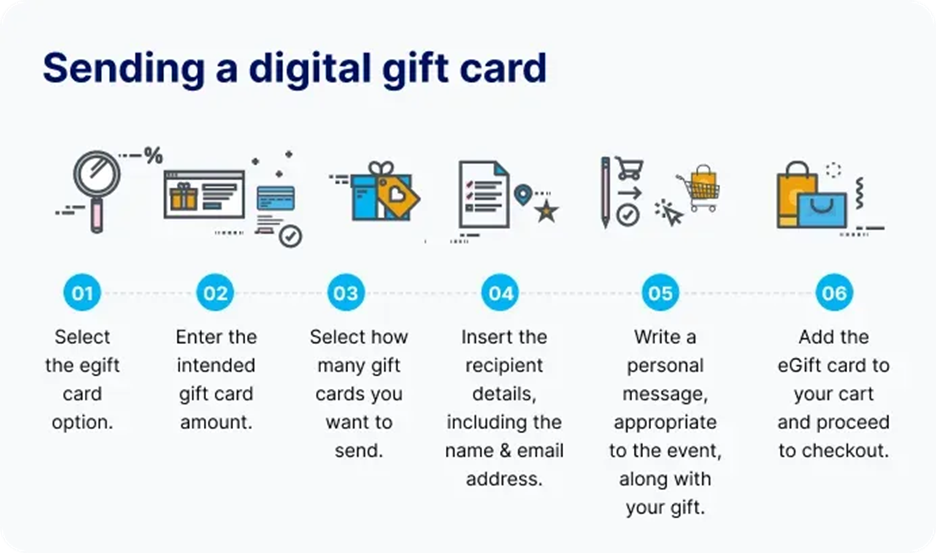Physische und digitale Geschenkkarten: Eine gründliche Wettbewerbsanalyse
Physische oder digitale Geschenkkarten - welche eignet sich am besten für moderne Geschenke? Dieser Blog vergleicht beide Varianten hinsichtlich Liefergeschwindigkeit, Kosten, Personalisierung, Skalierbarkeit und Benutzerfreundlichkeit, um Ihnen bei der Wahl der perfekten Option für Mitarbeiterbelohnungen oder Kundengeschenke zu helfen.
Auf dieser Seite
- Was ist eine physische Geschenkkarte?
- Was ist eine digitale Geschenkkarte?
- Physische vs. digitale Geschenkkarten: Der Unterschied
- Warum sind digitale Geschenke besser als physische Geschenke?
- Wie man eine digitale Geschenkkarte verschickt
- The Smart Shift: Wie digitale Belohnungen zu echten Ergebnissen führen
Vom höhlenbewohnenden Mann, der einer Frau ein kleines, glänzendes Stück einzigartigen Gesteins schenkte, bis hin zum hochmodernen Modus Operandi der digitalen Geschenke hat die Tradition des Schenkens - der schönste Ausdruck von Dankbarkeit, Liebe und Respekt gegenüber anderen Menschen - einen langen Weg hinter sich.
Und wie eine Regel der Gleichzeitigkeit ist auch das Schenken von Unternehmen davon nicht unberührt geblieben. Man muss schon besonders blind sein, um die wachsende Bedeutung digitaler Geschenke in der heutigen Welt zu ignorieren, sowohl im privaten als auch im beruflichen Bereich.
In diesem Blog werden wir die Unterschiede zwischen physischen und digitalen Geschenkkarten gründlich untersuchen und herausfinden, warum digitale Geschenkkarten den physischen Karten überlegen sind.
Was ist eine physische Geschenkkarte?
Physische Geschenkkarten sind greifbare, vorinstallierte Karten - in der Regel aus Plastik oder dickem Papier -, die mit einem bestimmten Geldwert versehen sind und als Zahlungsmittel in bestimmten Einzelhandelsgeschäften, Restaurants oder Online-Plattformen verwendet werden können.
Sie sind häufig mit einem Barcode, Magnetstreifen oder einem eindeutigen Code versehen und werden häufig für persönliche oder Firmengeschenke verwendet, wobei die Empfänger flexibel wählen können, was sie kaufen möchten.
➼ Der weltweite Geschenkkartenmarkt wird voraussichtlich von 1,09 Billionen US-Dollar im Jahr 2023 auf 1,29 Billionen US-Dollar im Jahr 2024vwachsen, was einer durchschnittlichen jährlichen Wachstumsrate (CAGR) von 18,4 % entspricht. Dieser Anstieg ist auf die Zunahme des E-Commerce, das höhere verfügbare Einkommen und die stärkere Nutzung mobiler Zahlungsmittel zurückzuführen.
➼ Ein wichtiger Trend im Jahr 2024 ist der rasche Anstieg von digitalen und elektronischen Geschenkkarten. Mit dem Wachstum des digitalen Zahlungsverkehrs und des E-Commerce entscheiden sich immer mehr Verbraucher für die Bequemlichkeit virtueller Geschenkkarten, die sofort geliefert werden können und über mobile Apps und Online-Plattformen einfacher zu verwenden sind.
➼ Der weltweite Markt für digitale Geschenkkarten erreichte im Jahr 2024 ein Volumen von 453,4 Mrd. USD und wird voraussichtlich mit einer CAGR von 13,32 % auf 1.531,5 Mrd. USD im Jahr 2033 wachsen. Dieses Wachstum wird durch den expandierenden E-Commerce-Sektor und die zunehmende Akzeptanz von digitalen Geschenkkarten aufgrund ihrer Bequemlichkeit und Flexibilität angetrieben.
Was ist eine digitale Geschenkkarte?
Eine digitale Geschenkkarte, auch bekannt als elektronische, virtuelle oder mobile Geschenkkarte, ist eine virtuelle Geschenkoption, die es ermöglicht, das Geschenk der Wahl auf elektronischen Plattformen einzulösen. Sie kann in Form von Codes oder prämienbasierten Links vorliegen und dem Empfänger per Telefon oder E-Mail zugesandt werden.
Eine digitale Geschenkkarte funktioniert genau wie eine normale Geschenkkarte. Je nach Anbieter der Karte können Sie diesen Code online und im Geschäft verwenden. Beachten Sie, dass sie eine gültige Alternative zu Bargeld ist.
Abgesehen von der Einfachheit des Versendens und Empfangens bringen digitale Geschenkkarten sowohl dem Absender (Unternehmen) als auch dem Empfänger (Mitarbeiter, Kunden, Partner) einen bedeutenden Wert. Die folgenden Wertmerkmale sind nur die Spitze des Eisbergs.
Physische vs. digitale Geschenkkarten: Der Unterschied
Vergleicht man diese atemberaubende Akzeptanz und das Wachstum der digitalen Geschenke mit den physischen Geschenkkarten - stolze 6 %-, so verschwinden selbst die geringsten Zweifel an der Vormachtstellung der Ersteren so schnell wie der Dampf. Warum sind digitale Geschenkkarten sowohl bei Unternehmen als auch bei Nicht-Unternehmen so beliebt?
Hier ist ein kurzer Vergleich:
|
Merkmal |
Physische Geschenkkarten |
Digitale Geschenkkarten |
|
Lieferfrist |
Bei physischen Geschenkkarten kann es Tage oder sogar
Wochen dauern, bis sie den Empfänger erreichen, weil Druck, Verpackung und Kurierdienst Verzögerungen verursachen. |
Sofort oder zu einem bestimmten Zeitpunkt zugestellt
und bietet so Schnelligkeit und Flexibilität. |
|
Zeitverbrauch |
Die Verwaltung von Lagerbeständen, Verpackung,
Versand und Nachverfolgung sind mit erheblichem Aufwand und Koordination verbunden. |
Niedrigdigitale Geschenke können innerhalb
Minuten verschickt werden, auch an große Gruppen, und zwar automatisch. |
|
Einlösungsmethode |
Der Empfänger muss ein Geschäft aufsuchen oder
die Karte manuell eingeben, was mühsam sein kann. |
Die Beschenkten können den Gutschein sofort online oder
in der Filiale einlösen, indem sie den Code, den Link oder die Punkte verwenden. |
|
Einschränkungen bei der Geschenkauswahl |
Oft auf eine bestimmte Marke oder
die möglicherweise nicht jedem Empfänger zusagen. |
Bietet Zugang zu einem breiten
Katalog - die Empfänger können Geschenke auswählen, die ihrenii5 Vorlieben entsprechen. |
|
Anpassungsoptionen |
Begrenzte Personalisierung - in der Regel nur die
gedruckte Nachricht oder das Kartendesign. |
Umfangreiche Optionen - individuelle Botschaften,
Themen, Werte und Branding für Veranstaltungen oder Anlässe. |
|
Risiko von Verlust/Beschädigung |
Karten können verloren, gestohlen oder beschädigt werden
beschädigt werden, was zur Unzufriedenheit der Kunden führt. |
Minimales Risiko - digitale Geschenke werden in
E-Mail, SMS oder Apps gespeichert und können erneut ausgestellt werden. |
|
Auswirkungen auf die Umwelt |
Verursacht Plastik, Papier und Kohlenstoff
Emissionen aus der Logistik - weniger umweltfreundlich. |
Umweltbewusst - eliminiert den Bedarf an
Druck, Verpackung und Lieferfahrzeuge. |
|
Skalierbarkeit |
Schwer zu skalieren - Massenbestellungen, Lagerhaltung,
und Versandlogistik machen Massengeschenke langsam. |
Hochgradig skalierbar - perfekt für große Teams,
globale Kunden oder Umfrageanreize. |
|
Kosten für den Vertrieb |
Inklusive Druck, Verpackung, Versand,
und Handhabung, die sich schnell summieren. |
Sehr niedrig - die meisten Plattformen berechnen nur den
den Wert des Geschenks und optionale Plattformgebühren. |
|
Integration mit digitalen Werkzeugen |
Eingeschränkte oder fehlende Möglichkeiten zur Anbindung an HR,
CRM- oder Kundenbindungsplattformen. |
Nahtlose Integration mit CRMs, HRMS,
Belohnungs- und Treuesysteme über APIs. |
|
Verfolgung und Berichterstattung |
Eine manuelle Verfolgung ist erforderlich, was
die Fehlerhäufigkeit erhöht und den Abgleich verlangsamt. |
Digitale Tools bieten Echtzeit-Tracking,
Einlösungsberichte und Einblicke in die Leistung. |
|
Idealer Anwendungsfall |
Ideal für persönliche Veranstaltungen, luxuriöse
Präsentationen oder traditionelle Firmengeschenke. |
Ideal für Remote-Mitarbeiter, Echtzeit-Anerkennung
Anerkennung und globale Anreizprogramme. |
Warum sind digitale Geschenke besser als physische Geschenke?
Hier sind zehn Gründe, warum digitale Geschenke besser sind als physische Geschenke:
1. Enormer Spielraum für Personalisierung
Der wahrgenommene Wert eines Geschenks ergibt sich aus der persönlichen Bindung, die es hervorruft, und zahlreiche Studien belegen dies nachdrücklich.
- Die Nachfrage der Verbraucher nach Personalisierung: Die Deloitte-Studie "Consumer Loyalty Survey 2024 " zeigt, dass die Verbraucher zunehmend personalisierte, flexible und digital ausgerichtete Kundenbindungsprogramme wünschen.
- Personalisierung stärkt die Kundenbindung: Ein Bericht von Forrester zeigt, dass Verbraucher personalisierte Erlebnisse schätzen, die relevant und wertvoll sind, was darauf hindeutet, dass Personalisierungsmaßnahmen die Kundentreue erheblich beeinflussen können.
- Personalisierung als Wettbewerbsvorteil: Die Erkenntnisse von Gartner deuten darauf hin, dass Unternehmen, die Verbrauchertrends nutzen, um personalisierte und ansprechende Kundenerlebnisse zu schaffen, eine höhere Kundenzufriedenheit und -treue verzeichnen.
Mit der Freiheit, die Stückelung festzulegen und sich nicht an einen vorgegebenen Betrag halten zu müssen, alle Elemente der Geschenkkarte zu verändern, vom Gesicht bis hin zu einer feierlichen Fliege zum "Auspacken" der Karte, können die Absender mit virtuellen Geschenken den denkbar höchsten Grad an Personalisierung erreichen.
2. Sofortige Befriedigung macht geografische Barrieren unbedeutend
Digitale Geschenkkarten werden per SMS, E-Mail oder über spezielle Geschenk-Apps an den Empfänger gesendet. Dies garantiert eine sofortige Zustellung - und macht digitale Geschenkkarten zur besten Wahl, wenn Ihre Mitarbeiter oder Kunden in einem anderen Land oder Kontinent leben.
Sie ersparen sich damit nicht nur die Verzögerungen, die durch grenzüberschreitende Probleme entstehen können. Sie ersparen Ihren Mitarbeitern und Kunden auch den Gang zum Laden und das Anstehen in langen Schlangen, um das Geschenk einzulösen.
Alles, was sie brauchen, sind ein paar Klicks, und das Geschenk ihrer Wahl ist auf dem Weg. Außerdem bieten digitale Geschenkplattformen wie Plum mehrsprachige Dienste an, die es Ihnen ermöglichen, ein persönliches Geschenk und eine persönliche Botschaft zu verfassen, ohne Angst haben zu müssen, dass es falsch übersetzt wird.
3. Geringe Kosten, hohe Wirkungsaussichten

Stellen Sie sich vor, Sie versenden tausend physische Geschenke an Tausende von Mitarbeitern/Kunden an verschiedenen Standorten?
Angefangen bei der Beschaffung von Geschenken, die zu jeder Persona passen, bis hin zur Aufnahme in das Inventar; und von der Sicherstellung der richtigen Zustellung auf der letzten Meile durch externe Lieferpartner bis hin zur Abwicklung der Rücksendung von Geschenken, falls die Adresse falsch oder nicht aktualisiert ist, werden die Kosten überall geschrieben.
Die Anzahl der Empfänger hingegen ist für den Absender digitaler Geschenke unbedeutend. Der Absender muss lediglich Codes oder Links an die Empfänger senden, was das Unternehmen nichts kostet. Ebenso ist es viel billiger, eine falsche E-Mail-Adresse im System zu ersetzen, als eine zusätzliche Fahrt aufgrund einer falschen physischen Adresse in Kauf zu nehmen.
4. Idee für Last-Minute-Geschenke

Auch wenn Ihr Firmengeschenkprogramm mit den Namen der Empfänger und den üblichen Verdächtigen noch so gut geplant ist, kann ein Bedarf an Last-Minute-Geschenken aus heiterem Himmel auftauchen.
Ihr Vertriebsteam hat vielleicht eine ansehnliche Summe aus einem nicht ganz so glanzvollen warmen Lead herausgeholt, oder das Unternehmen Ihres geschätzten Kunden stand bei der Verleihung eines glorreichen Wirtschaftspreises auf dem Podium.
Diese Leistungen sind beim besten Willen ein Geschenk von Ihnen wert. Der Nachteil ist jedoch, dass Sie diese Möglichkeit nicht in Ihre Geschenkplanung einbezogen haben, so dass Sie Gefahr laufen, eine wirklich verdiente Geschenkmöglichkeit zu verpassen.
Digitale Geschenkkarten sind in dieser krisenhaften Situation der eigentliche Retter, im wahrsten Sinne des Wortes. Wo herkömmliche Geschenkkarten innerhalb von 6 bis 8 Tagen zugestellt werden, landen digitale Geschenkkarten innerhalb von 24 Stunden in den digitalen Räumen der Empfänger.
Außerdem vermeiden sie durch Automatisierung, dass Sie wichtige Ereignisse, die ein Geschenk wert sind, verpassen.
5. Keine Möglichkeit, sie zu verlegen

Eines der besten Dinge an digitalen Geschenkkarten ist, dass sie unverlierbar sind. Sie bleiben dauerhaft in Ihrer E-Mail und Nachricht. Das ist eine große Erleichterung für Ihre Mitarbeiter/Kunden, die sich Sorgen machen, ihre Karten oder ihr Bargeld zu verlegen.
40 % der 18- bis 29-Jährigen waren damit einverstanden, ihre physischen Geschenkkarten zu verlieren, kurz bevor sie sie ausgeben wollten.
"Elektronische Geschenkkarten sind definitiv schwieriger zu verlieren. Sie können in Ihrer E-Mail existieren, im Gegensatz zu einem Stück Plastik, das es vielleicht in Ihre Brieftasche schafft oder auch nicht".
6. Leicht zu vergrößern

Da die meisten digitalen Geschenkplattformen API-basiert sind, ist das Hinzufügen einer ganz neuen Kategorie von Geschenken und ihrer jeweiligen Anbieter weniger zeitaufwändig und geldsparend. Die Entwickler und Systemtechniker können die Integration innerhalb weniger Tage vornehmen und so Ihre Markteinführungszeit verkürzen.
Der größte Vorteil dieser Zeiteffizienz besteht darin, dass Sie den Puls der Geschenktrends fühlen und wissen, was Ihre Mitarbeiter/Kunden als Firmengeschenk wünschen, und dass Sie Ihr Geschenkprofil ändern können. Dadurch wird Ihr Geschenkvorhaben relevanter und für die Empfänger sehr begehrenswert.
7. Geringeres Risiko von Betrug und Missbrauch

Da die Informationen auf digitalen Geschenkkarten zum Zeitpunkt des Kaufs generiert und direkt an Sie oder den Empfänger gesendet werden, ist die Wahrscheinlichkeit geringer, dass Sie Opfer eines beliebten Geschenkkartenbetrugs werden, nämlich des Skimming von Geschenkkarten.
Außerdem zahlen Sie nur für die eingelösten Geschenke - und alle diese Transaktionen sind für Sie in Echtzeit verfügbar. Sollten Sie Unstimmigkeiten jeglicher Art feststellen, können Sie sich mit dem Kundendienst der Plattform für digitale Geschenke in Verbindung setzen und die Zweifel ausräumen lassen.
8. Sie sind umweltfreundlich
In einer Zeit, in der der Klimawandel keine Fiktion mehr ist, sondern Realität, und Naturkatastrophen uns mit der Regelmäßigkeit eines Pendels treffen, ist die Erhaltung der natürlichen Ressourcen der Schlüssel zum Überleben unseres Planeten.
Physische Geschenkkarten stehen dem nämlich entgegen:
- Sie fordern die Abholzung wertvoller Bäume für die Herstellung einer Plastikkarte, die als einmaliger Gutschein fungiert.
- Der physische Versand von Geschenken belastet die Welt mehr als der digitale.
- Digitale Geschenkkarten müssen nicht auf Plastik oder Papier gedruckt werden, wodurch die sündhafte Verschwendung natürlicher Ressourcen vermieden wird.
Bei einer mikroskopischen Betrachtung dieser Klimaanforderungen können die Vorteile, die digitale Geschenkkarten garantieren, nicht deutlicher herausgestellt werden.
Wie man eine digitale Geschenkkarte verschickt
Das Versenden einer digitalen Geschenkkarte dauert in jedem Fall nicht länger als eine Minute. Hier sind die Schritte zum Versenden einer elektronischen Geschenkkarte.

Um eine digitale Geschenkkarte zu versenden, wählen Sie zunächst eine Geschenkkarte von einer vertrauenswürdigen Plattform, die Vielfalt und Komfort bietet. Wählen Sie die Marke und den Wert aus, fügen Sie eine persönliche Nachricht hinzu und geben Sie die E-Mail-Adresse oder Handynummer des Empfängers ein. Sie können die Karte sofort versenden oder für einen späteren Zeitpunkt planen. Das ist eine schnelle, durchdachte und unkomplizierte Art, seine Wertschätzung zu zeigen.
Xoxoday Plum ermöglicht Ihnen den Zugriff auf einen riesigen globalen Katalog digitaler Geschenkkarten, zusammen mit nahtlosen Lieferoptionen und voller Kontrolle über Personalisierung, Tracking und Reporting - die perfekte Plattform für müheloses und wirkungsvolles Schenken in großem Umfang.
The Smart Shift: Wie digitale Belohnungen zu echten Ergebnissen führen
Kantar, ein weltweit führendes Datenanalyse- und Beratungsunternehmen, stand vor einer bekannten Herausforderung: Wie kann man Umfrageteilnehmer in großem Umfang motivieren und gleichzeitig den Belohnungsprozess rationalisieren? Durch den Wechsel zu digitalen Geschenkgutscheinen von Xoxoday Plum konnten die Teilnehmer aus über 21.000+ Prämienoptionen in 100 Ländern. In nur drei Monaten wurden erfolgreich Prämien im Wert von über 3,32 Millionen Dollar verteilt, ohne dass die ineffiziente manuelle Verteilung der Prämien erforderlich war.
Die Erfolgsgeschichte von Kantar ist ein klarer Indikator dafür, wohin sich Corporate Gifting entwickelt - hin zu digitalen, skalierbaren und personalisierten Erfahrungen.
Dieser Wandel ist nicht nur praktisch, sondern auch strategisch. Ganz gleich, ob Sie Umfrage-Incentives, Kundengeschenke oder Mitarbeiteranerkennungen verwalten, Plum bietet Ihnen eine leistungsstarke digitale Prämienplattform, die globale Reichweite mit nahtloser Automatisierung kombiniert. Passen Sie Belohnungen an, vereinfachen Sie Arbeitsabläufe und werten Sie jede Interaktion auf - ohne die Reibung der Logistik oder manueller Prozesse.
Sind Sie bereit, Ihre Reward-Strategie zu verändern, wie Kantar es getan hat? Vereinbaren Sie eine kostenlose Demo und wir bringen Sie auf den Weg!


















